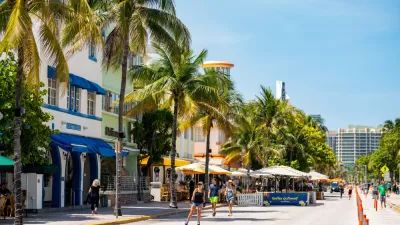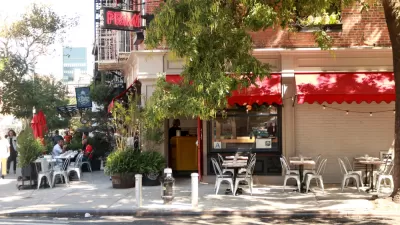While some open streets experiments have met with backlash from community members, others were so successful they led to permanent changes.

An article by Maylin Tu in Next City expounds on the benefits of car-free streets, which got a shot in the arm during the Covid-19 pandemic and, in some cities, are having lasting impact.
Tu lists the common arguments against open streets and the evidence debunking them, going on to describe four cities where open streets experiments are still going strong. “Car-free advocates would say that as greenhouse gas emissions and traffic violence go down, happiness and connection go up — it’s hard to connect with your neighbors while ensconced in two tons of steel.”
The four featured projects: San Francisco’s John F. Kennedy Drive, which winds through Golden Gate Park and has been closed to cars on Sundays since 1967; Griffith Park Drive in Los Angeles, which was closed to cars after the death of a cyclist in April; 34th Avenue in New York City, which, although not permanently closed to vehicle traffic, hosts a vibrant community of events and classes during daytime hours; and Dublin’s Capel Street, now the longest car-free street in Ireland.
Tu points out that well before the pandemic, cities like Paris, Bogotá, and São Paulo were experimenting with projects like car-light or car-free streets, open streets events, and parklets, but the success of pandemic-era programs has, in some cases, accelerated efforts to reclaim public right-of-way from cars.
FULL STORY: In These Cities, Car-Free Streets Are Here To Stay

Alabama: Trump Terminates Settlements for Black Communities Harmed By Raw Sewage
Trump deemed the landmark civil rights agreement “illegal DEI and environmental justice policy.”

Planetizen Federal Action Tracker
A weekly monitor of how Trump’s orders and actions are impacting planners and planning in America.

The 120 Year Old Tiny Home Villages That Sheltered San Francisco’s Earthquake Refugees
More than a century ago, San Francisco mobilized to house thousands of residents displaced by the 1906 earthquake. Could their strategy offer a model for the present?

In Both Crashes and Crime, Public Transportation is Far Safer than Driving
Contrary to popular assumptions, public transportation has far lower crash and crime rates than automobile travel. For safer communities, improve and encourage transit travel.

Report: Zoning Reforms Should Complement Nashville’s Ambitious Transit Plan
Without reform, restrictive zoning codes will limit the impact of the city’s planned transit expansion and could exclude some of the residents who depend on transit the most.

Judge Orders Release of Frozen IRA, IIJA Funding
The decision is a victory for environmental groups who charged that freezing funds for critical infrastructure and disaster response programs caused “real and irreparable harm” to communities.
Urban Design for Planners 1: Software Tools
This six-course series explores essential urban design concepts using open source software and equips planners with the tools they need to participate fully in the urban design process.
Planning for Universal Design
Learn the tools for implementing Universal Design in planning regulations.
Clanton & Associates, Inc.
Jessamine County Fiscal Court
Institute for Housing and Urban Development Studies (IHS)
City of Grandview
Harvard GSD Executive Education
Toledo-Lucas County Plan Commissions
Salt Lake City
NYU Wagner Graduate School of Public Service





























